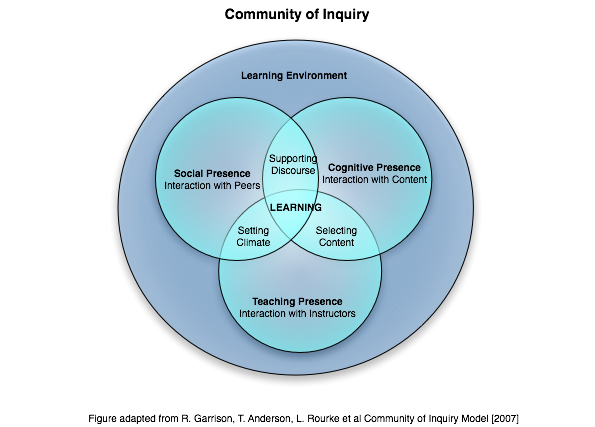Documentation:Supporting Critical Thinking Online/Critical Thinking and Cognitive Presence
Critical Thinking and Cognitive Presence
Garrison, Archer & Anderson (2001) propose a generalized model of practical inquiry which they feel reflects the critical thinking process and the means to create cognitive presence in the online environment.
Their focus is on the process and evidence of critical thinking within the group or community of inquiry. Anderson, Garrison and Archer also stress the importance of both the shared and private worlds of the learner as key to understanding how to create and support cognitive presence in an educational context.
In the diagram below, the private dimension reflects the continuum between action and deliberation. This may be where learners consider their prior experience, background knowledge and their strategies for thinking that they apply to think critically about the information presented to them. The public dimension represents the transition between the abstract and concrete. Another way to look at it might be the application of those habits of mind, values and attitudes about good thinking as they contribute their ideas and respond to the ideas presented by others.

The work of Randy Garrison and Terry Anderson highlights three essential and overlapping elements of an online learning environment in their Community of Inquiry Model: Cognitive Presence, Social Presence and Teaching Presence. It is the cognitive presence that is most closely tied to critical thinking.
In the Community of Inquiry model, cognitive presence describes learner participation in a process of “critical, practical inquiry”, in engaged collaboration with fellow learners. The instructor's role then, is to encourage and support discourse between students by designing activities which promote engagement with the subject and dialogue with each other; modelling and supporting the development of good facilitation skills through the use of good questions, clear communication and clarification regarding important concepts that are under analysis and thinking through an approach to assessment that focuses on the application of critical thinking in collaborative inquiry.

Garrison, Anderson and Archer's Model of Practical Inquiry offers a framework for helping us understand cognitive presence from the perspective of the learner and the processes engaged in while establishing that presence online.
Xin & Feenberg (2006) expand on this idea by proposing that the goals of cognitive presence, or “intellectual engagement” are:
- for individuals to acquire new concepts and achieve conceptual change
- for the group to achieve convergence
These two outcomes are connected: individuals achieve conceptual change through a collaborative “struggle for convergence” in which the group co-constructs new knowledge. In this case, convergence does not necessarily mean total agreement but rather a state of equilibrium - where individuals are enlightened by the discussion. The instructor's role is to provide leadership (perhaps in collaboration with other students) and moderate the discussion in such a way as to keep students motivated by engaging them in discussion and taking opportunities to clarify concepts and extend knowledge of the subject area without "lecturing". The figure below suggests one representation of these dynamics.

Reading Review
- Xin, C. & Feenberg, A. (2006). Pedagogy in Cyberspace: The Dynamics of Online Discourse. Journal of Distance Education 21 (2):1-25. Review pages 5-15.
- Garrison, D. R., Anderson, T. & Archer, W. (2000). inquiry in a text-based environment: Computer Conferencing in Higher Education. The Internet and Higher Education, 2(2), 87-105. Review pages 98-99.